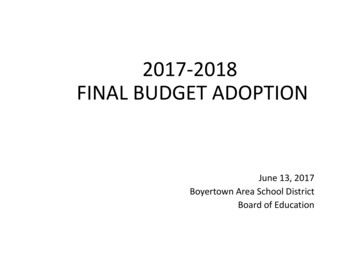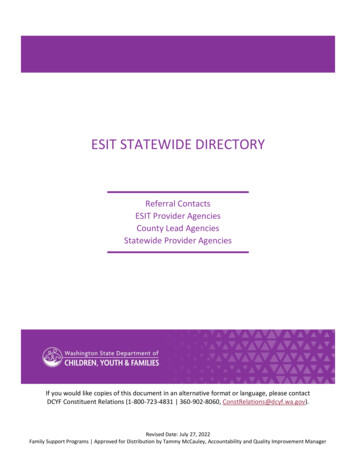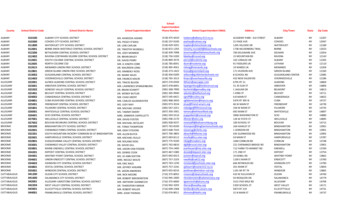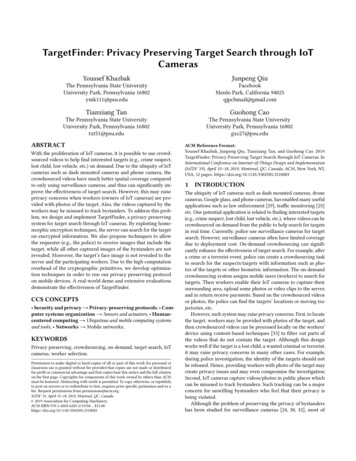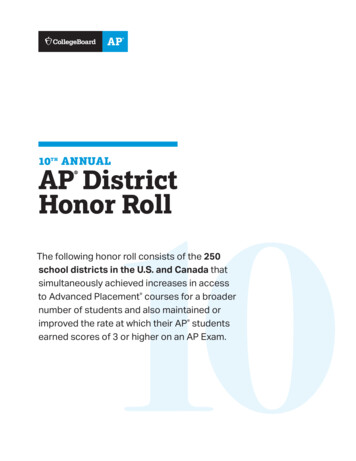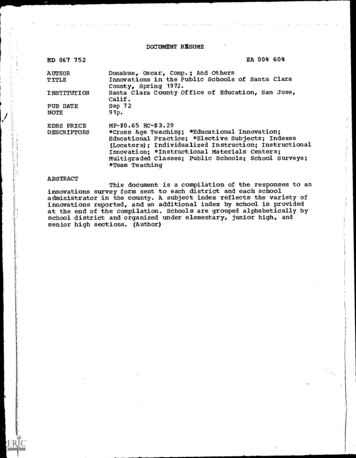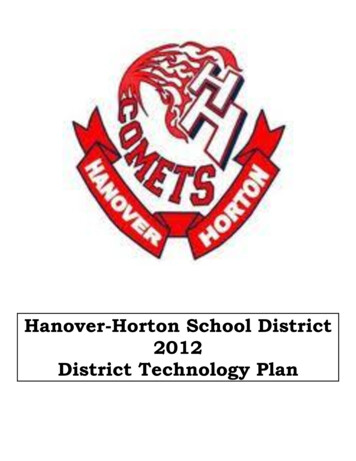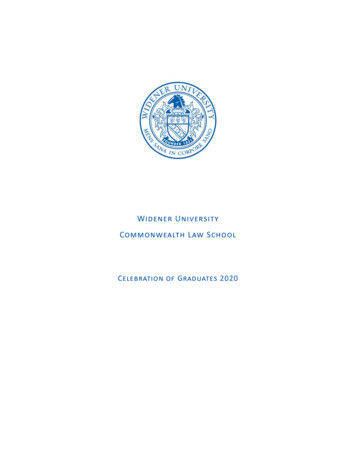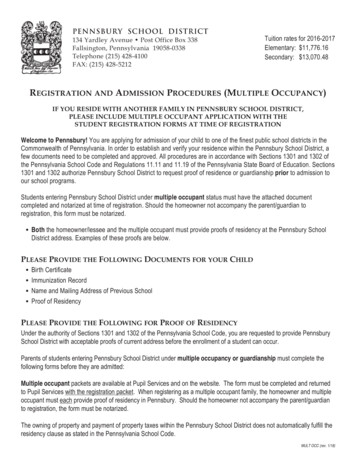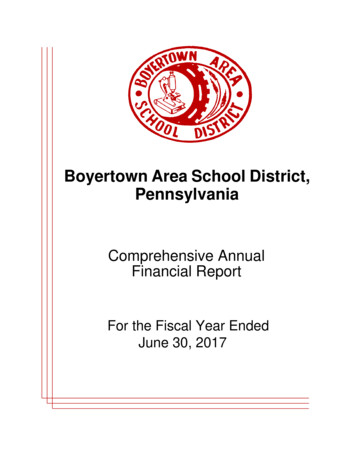
Transcription
Boyertown Area School District,PennsylvaniaComprehensive AnnualFinancial ReportFor the Fiscal Year EndedJune 30, 2017
COMPREHENSIVEANNUALFINANCIAL REPORTBoyertown Area School District, PennsylvaniaFor the Fiscal Year Ended June 30, 2017Prepared by: Michael Taylor, CPA
BOYERTOWN AREA SCHOOL DISTRICTTABLE OF CONTENTSPAGEINTRODUCTORY SECTIONLetter of TransmittaliList of Principal OfficialsxBoyertown Area School District Organizational ChartxiFINANCIAL SECTIONIndependent Auditor’s Report1-3Management’s Discussion and Analysis4 - 12Basic Financial StatementsEntity-wide Financial Statements:- Statement of Net Position13- Statement of Activities14Fund Financial Statements:- Balance Sheet - Governmental Funds15- Reconciliation of Balance Sheet - Governmental Fundsto Statement of Net Position16- Statement of Revenues, Expenditures, and Changes inFund Balances - Governmental Funds17- Reconciliation of Statement of Revenues, Expenditures,and Changes in Fund Balances - Governmental Fundsto Statement of Activities18- Budgetary Comparison Statement - General Fund19- Statement of Net Position - Proprietary Funds20- Statement of Revenues, Expenses, and Changes inNet Position - Proprietary Funds21
BOYERTOWN AREA SCHOOL DISTRICTTABLE OF CONTENTSPAGE- Statement of Cash Flows - Proprietary Funds22- Statement of Net Position - Fiduciary Funds23- Statement of Changes in Net Position - Fiduciary Fund24Notes to Financial Statements25 - 53Required Supplementary Information- Schedule of the District’s Proportionate Share of the Net Pension Liability54- Schedule of District Contributions55- Schedule of Funding Progress for Postemployment Benefits Plan56Supplementary Information- Combining Balance Sheet – Nonmajor Governmental Funds57- Combining Statement of Revenues, Expenditures, and Changes inFund Balances – Nonmajor Governmental Funds58STATISTICAL SECTIONNet Position by Components60 - 61Changes in Net Position62 - 65Fund Balances, Governmental Funds66 - 67Changes in Fund Balances, Governmental Funds68Tax Revenues by Source, Governmental Funds69Assessed Value and Actual Value of Taxable Property70Direct and Overlapping Property Tax Rates71 - 72Principal Property Taxpayers73Property Tax Levies and Collections74
BOYERTOWN AREA SCHOOL DISTRICTTABLE OF CONTENTSPAGERatio of Outstanding Debt by Type75Ratio of General Bonded Debt by Type76Direct and Overlapping Governmental Activities Debt77Legal Debt Margin Information78Demographic and Economic Statistics79Principal Employers80School Building Information81Operating Statistics82School Lunch Program83Professional Teaching Staff84Miscellaneous Statistics85 - 86SINGLE AUDIT SECTIONIndependent Auditor’s Report on Internal Control Over FinancialReporting and on Compliance and Other Matters Based on anAudit of Financial Statements Performed in Accordance withGovernment Auditing Standards87 - 88Independent Auditor’s Report on Compliance for EachMajor Program and on Internal Control Over ComplianceRequired by the Uniform Guidance89 - 90Schedule of Expenditures of Federal Awards91 - 92Notes to Schedule of Expenditures of Federal AwardsSchedule of Findings and Recommendations9394 - 95
INTRODUCTORY SECTION
BOYERTOWN AREA SCHOOL DISTRICTEDUCATION CENTER“to enable all students to succeed in a changing world”January 12, 2018To the Board of School Directors and the Citizens of Boyertown Area School District:We are pleased to present the Comprehensive Annual Financial Report (CAFR) for the Boyertown AreaSchool District, Pennsylvania, for the fiscal year ended June 30, 2017. The District’s Business Officeprepared this CAFR. Responsibility for both accuracy of the presented data and the completeness andfairness of the presentation, including all disclosures, rests with the management of the District. We believethe data as presented is accurate in all material respects. It is presented in a manner designed to fairly setforth the financial position and results of operations of the District as measured by the financial activity ofits various funds. All disclosures necessary to enable the reader to gain a clear understanding of theDistrict’s financial affairs have been included.The organization, form, contents of this CAFR, the accompanying financial statements, and the statisticaltables were prepared in accordance with the standards established by the Governmental AccountingStandards Board (GASB), the Government Finance Officers Association (GFOA), the American Institute ofCertified Public Accountants (AICPA), the Association of School Business Officials (ASBO), and the PublicSchool Code of 1949, as amended, of the Commonwealth of Pennsylvania.Generally accepted accounting principles require that management provide a narrative introduction,overview, and analysis to accompany the basic financial statements in the form of Management’sDiscussion and Analysis (MD&A). This letter of transmittal is designed to complement the MD&A andshould be read in conjunction with it. The Boyertown Area School District’s MD&A can be foundimmediately following the report of the independent auditors.Profile of the GovernmentThis CAFR includes all funds of the District, consistent with the guidance contained in GASB 14, TheFinancial Reporting Entity, GASB 39, Determining Whether Certain Organizations Are Component Units,and GASB 61, The Financial Reporting Entity: Omnibus - an Amendment of GASB Statements No. 14 andNo. 34. The criteria used by the District to evaluate whether additional entities should be included in theDistrict’s reporting entity as component units includes whether the District can impose its will on theseentities and whether these entities bring the District financial benefit or burden.A related organization excluded is the Berks Career and Technology Center (Vo-Tech). A joint boardconsisting of school directors from each member district runs the Vo-Tech. Each member district pays ashare of the operating costs, debt, and approves the Vo-Tech’s budget. Since the District cannot imposeits will or have a voting majority, the Vo-Tech is considered a joint venture.911 Montgomery Avenue Boyertown PA 19512-9607 (610) 367-6031i FAX (610) 369-7620 wwww.boyertownasd.org
Local EconomyThe Boyertown Area School District is situated on the northwestern edge of the greater Philadelphiasuburban sprawl in southeastern Pennsylvania. About 45 miles northwest of Philadelphia, it is just 20 milessouth of Allentown and 20 miles east of Reading, straddling the Montgomery-Berks County line. When itwas formed as a jointure in 1953, it was one of the largest school districts in the State, covering nearly 100square miles. It encompasses Colebrookdale, Douglass, Earl, and Washington Townships and theBoroughs of Bally, Bechtelsville, and Boyertown in Berks County plus the Townships of Douglass, NewHanover, and Upper Frederick in Montgomery County. The population in the District is over 40,000. Withroom for growth in the northern and eastern regions of the District, it is expected the population will increasein the future.The District has been shifting from a predominance of farming and blue-collar homes to a suburban-typecommunity. The preponderance of "new-comers" finds their employment outside the District boundaries inthe King of Prussia, Exton, Allentown, or Reading areas. The fairly recent modernization of U.S. Route422, a major artery into the Philadelphia area, which just barely brushes the southern edge of the District,has caused more rapid growth on the eastern, or Montgomery County, side. Pennsylvania Routes 100 and73 provide the other major traffic arteries across the District.Approximately 6,900 students in the District are educated in 10 modern buildings. Seven K-6 elementaryschools funnel students into one of two 7-9 junior high schools. There is one senior high school servinggrades 10, 11, and 12. Geographic size makes school bus transportation a fact of life for better than 90percent of the student body at all levels, as presented by the map on the next page. The shaded area ofthe map is the area of the Boyertown Area School District. The blue line that circles the District representsthe ten-mile radius beyond the District’s boundaries. According to policy, the District “will providetransportation for resident students who attend non-public schools not operated for profit located within theDistrict geographic boundaries or outside the boundaries via the nearest paved public highway when thedistance does not exceed ten miles from the district boundaries.”Student population has been stable with variations less than 100 students per year. With the possibility ofnew home construction dependent on the economic climate, the student population is expected to increase.The District’s tax base had leveled due to the recessionary economy, but recent tax collection results reflectsigns of recovery in the Boyertown housing market. New home construction on open land has slowedconsiderably from the growth experienced in the early 2000s, but the Montgomery County portion of theDistrict has added an average of 100 new homes per year. Due to the real estate market decline, theDistrict has experienced a moderate level of assessment appeals. The District has a delinquent taxprogram which mitigated the decrease in collections. In addition, socioeconomic indices for per capitaincome and property values are very favorable relative to other areas of the State.It appears that there may be construction of one or more major retailers within the District’s boundaries,although these plans have been slowed by the current economic conditions. There is a Walmart on Route100 and a Giant grocery store near the intersection of Routes 100 and 73. Big Lots, a major retail operation,has replaced the vacancy left by an Ames department store more than a decade ago. The recentcompletion of a Wawa convenience store along Route 100 reflects the increased plan to add commercialbusiness along this well-traveled corridor. These facilities have added value to the tax rolls as well ascreated new jobs for the local economy. The adverse effect of these major retailers would be that theycould possibly put the local stores out of business and cause congestion on an already heavily traveledinfrastructure. The plans for a shopping center expected to be constructed at Routes 73 and 663, tentativelyhousing a Home Improvement Warehouse and a major grocery store, are currently on hold. The growth ofa local company, Gateway Ticketing, caused the entity to move into a newly completed building which isii
the company’s headquarters near the boundaries of the Montgomery-Berks County line. This multi-milliondollar building has significantly added to the tax base of the District and is a very visible building along route100.Although the current economic downturn has affected the local economy, the unemployment rate in theDistrict continues to be below the national average.Long-term Financial PlanningThe District has experienced moderate growth in student population over the last decade. A shift inpopulation now has a majority of students attending from the eastern side of the District (MontgomeryCounty), which is served by three of the District’s 10 schools. To address overcrowding and to maintainiii
balanced classroom population, a redistricting plan has been implemented. Based on two commissioneddemographic and facility feasibility studies performed in the 2011-2012 fiscal year, the District hasdeveloped a plan to handle projected student growth and mitigating capacity issues at the elementaryschool level. Several construction projects are either underway or are planned to start over the next twoyears. The expansion of the Boyertown Area Senior High School to accommodate grades 9 through 12 isthe first scheduled project and commenced in February 2015 with a completion date scheduled for August2017. Renovations to the Junior High West Center are scheduled to begin in May 2017 with the completionestimated for August 2018. Additions to Colebrookdale Elementary and a new elementary school inMontgomery County may be considered for the future. The District completed a guaranteed energy savings(GESA) program under Act 77 in which energy savings initiatives were installed at every building exceptthe Senior High School and Junior High West. The projected utility savings over the next 20 years allowedthe District to install complete air conditioning systems at both Gilbertsville and New Hanover-UpperFrederick Elementary, and partial air conditioning at the remainder of the elementary buildings. Thecomplete air conditioning at these remaining buildings has the support of the School Board and is expectedto be completed within the next few years.The Commonwealth of Pennsylvania has addressed real estate tax reform through the passage of 2006Special Session, Act 1. Each public school in the Commonwealth must abide by Act 1. The District hadthe opportunity to swap education funding from the current property tax method to an increased income taxthrough a voter referendum in May 2007, but the measure was soundly rejected. Act 1 also provides apublished index that would allow school districts to raise taxes as needed up to the index before voterapproval would be sought to approve tax increases above the index. Act 1 also provides for the distributionof gambling revenues to school districts for the purpose of lowering the property tax to qualifiedhomeowners. Again, no additional funds would be received by the District for education. Currently, theState funds approximately 30 percent of the District’s programs.Cash Management Policies and PracticesCash temporarily idle during the year was invested in certificates of deposit, obligations of the U.S.Treasury, obligations of U.S. instrumentalities, obligations of other governmental units within theCommonwealth of Pennsylvania, and in an investment pool. The maturities of investments range from sixmonths to about five years. Investment income includes appreciation/depreciation in the fair value ofinvestments. Increases in fair value during the year do not necessarily represent trends that will continue;nor is it always possible to realize such amounts, especially in the case of temporary changes in the fairvalue of investments, that the government intends to hold to maturity.Risk ManagementThe District purchases commercial insurance for areas of potential losses. Additional information on theDistrict’s risk management activities can be found in Note 13 of the notes to the financial statements.Effective July 1, 2010, the District began to self-insure the medical benefits of the District’s employees. TheDistrict has stop-loss insurance which covers any single medical claim in excess of 150,000. June 30,2017 marked the seventh-year anniversary of the funding change, and the District has built a reserveamount of approximately 7 million, which increased 4 million over the last seven years. The compositepremium rates have increased by an average of less than five percent over the seven-year period and hasallowed the District to effectively manage the budgetary impact of healthcare. With the District assumingthe risk of healthcare claims normally incurred by an insurance company, the costs of healthcare have beenreasonably contained in comparison to the health industry’s cost escalation.iv
InitiativesCo-CurricularThe District is committed to a broad range of co-curricular activities for all students in grades kindergartenthrough twelfth grade. These programs range from athletics to music, theater and arts, service clubs, andvarious other clubs and programs. Present offerings include:Music and TheaterAthleticsService and School ClubsBand FrontChamber ChoirConcert ChoirJazz EnsembleMarching BandProductionsSenior Class PlayOrchestraTreble SingersVocal EnsembleBaseballBasketballCheerleadingCross CountryField nnisTrackWrestlingAcademic ChallengeActivate ClubAll Sports ClubArts / Crafts ClubBuilders ClubChess ClubDiversity ClubFBLA – Future BusinessLeaders of AmericaFHCC – Future HealthCareer ClubGames ClubInsight ClubInteract ClubJapanese GardenKey ClubLeo ClubLibrary ClubMath ClubNational Honor SocietyNewspaperPhotography ClubSADD – Students AgainstDestructive DecisionsSAVE – Students AgainstViolation of the EarthScience OlympiadStage CrewStudent CouncilTSA – Technology StudentAssociationVirtual Stock MarketYearbook ClubsYogaYouth/Model GovernmentThe District has strived to become a “No Place for Hate” District, being recognized as the first school districtin the State to have all of the District’s 10 schools designated. Various diversity activities are held at thebuilding and District levels.Instructional ServicesThe District’s Instructional Program is divided into Elementary Education: grades K-6 at seven sites; JuniorHigh School: grades 7-9 at two sites; Senior High School: grades 10-12 at one site. Responsibility foradministration and instructional leadership of the individual schools in the District is entrusted to thefollowing building principals for the 2016-2017 school year:Boyertown Elementary SchoolColebrookdale Elementary SchoolEarl Elementary SchoolGilbertsville Elementary SchoolNew Hanover-Upper Frederick Elementary SchoolPine Forge Elementary SchoolWashington Elementary SchoolJunior High EastJunior High WestSenior High SchoolMr. Craig KehlMr. Michael StoudtDr. Sara ObarowMrs. Stephanie LandisMr. Brian RohnMr. Stephan PronMr. Christopher J. IacobelliMr. Andrew RuppertMr. Gregory S. GaltereDr. Brett Cooperv
The instructional program includes the following subject areas:ArtBusiness EducationNJROTCFamily/Consumer ScienceWorld LanguageReading/Language Arts/EnglishLibraryMathematicsMusicScienceSocial StudiesTechnology EducationTelecommunicationsHealth and Physical EducationAll curricula indicate what the District expects students to know and to demonstrate as skills. Curriculumsare provided to each teacher with additional copies at each building level. Curricula have been adoptedbased on Core State Academic Standards and are being implemented in each area. Curriculum informationand our graduation requirements are available at individual buildings.The District is very proud that all curricula have been written by teams of staff members to meet the variousneeds of today’s learners. The District believes that, over the next five to six years, it must continue tofocus attention on the evolving State Academic Standards and assure that the District’s curriculum andinstructional programs meet the needs of all students.Remediation ProgramIn conjunction with State regulations, our District provides an intervention/remediation program for studentsin grades Kindergarten through twelve in all schools. The purpose of this program is to help studentsachieve State Academic Standards. The intervention/remediation program functions in various waysdepending upon the grade level and individual needs of the students.District Technology ProgramThe District submitted the State-mandated Technology Plan in September 2012. The three-year plan wasa reporting mechanism used by the State to determine the uses of technology within the District, whichallows them to track the changing technology trends in education. It is used by the District as a blueprintfor future technology implementation. The submission of a technology plan to the State is currently notrequired. The following District technology initiatives have been completed or are currently beingimplemented:The implementation of 1 to 1 laptop programs in grades 6 - 12The implementation of 1 to 1 laptop/iPad program in grades K - 5The ongoing support of a Bring Your Own Technology (BYOT) programThe integration of Single-Sign-On (SSO) across district applicationsThe migration of onsite file and email storage to the cloud (Office 365 and G-Suite)The implementation of a Business Continuity (BC) and Disaster Recovery (DR) siteThe ongoing enhancement of cyber school curriculum and services for all studentsThe purchase of software to support and enhance the curriculumThe implementation of Virtual Private Network (VPN) access for faculty, staff, and studentsThe implementation of family and community communication systemsThe District will continue to replace and upgrade computer and tablet technologies in all schools in supportof its 1 to 1 programs while ensuring anytime-anywhere access to curriculum, school, and districtinformation. The continued purchase of software and online programs for curriculum areas and forinstructional management is essential. Access to computers for teachers and the replacement and upgradevi
of all technology will aid in instruction. Currently, the District has more than 8,200 computers and 2,500iPads in place as well as peripherals, wired and wireless network, distance learning, television studios, andtechnology curriculums. The District delivers a Digital Citizenship curriculum and participates in theChildren’s Internet Protection Act established by the Federal Government. The Senior High activelyparticipates in the Cyber Patriot program and competes on a national level.Special Education ServicesThe Boyertown Area School District provides special education services and gifted support services to morethan 1,719 students, or 25 percent of the total 6,898 student enrollment. Of this, the percentage of disabledstudents is 20 percent. The District has 310 gifted students – approximately four and a half percent of totalenrollment. The number of students in out-of-district placements is approximately 88.Special Education Programs in Boyertown serve students that are intellectually disabled, hearing impaired,speech/language impaired, visually impaired, learning disabled, emotionally disturbed, physically disabled,other health impaired, traumatic brain injured, autistic, and gifted. Each neighborhood school operates itsown program with the exception of District life skills support, autistic support, and emotional support. Lifeskills support programs are offered at Colebrookdale Elementary School, Junior High East, and the SeniorHigh School. Autistic support programs are offered at Washington Elementary School, Junior High West,and the Senior High School. Emotional support programs are offered at Boyertown Elementary School,Junior High East, and the Senior High School.BASD Cyber-SchoolThe Boyertown Area School District offers a cyber-school option to our students. This program is availableto students in both our traditional schools but is also being utilized by students who had previously attendedother cyber-school programs. This instructional opportunity is being offered to students to help meetindividual instructional needs.District Program of AssessmentThe District has in place a standardized assessment system with a broad range of assessment instruments– Kindergarten through twelfth grade. This system is meant to be an addition to classroom and buildingassessments that are in place as part of the District’s curriculums. The District uses standardized testsprimarily to provide parents, teachers, and administrators with information to help diagnose skill andlearning deficiencies for individual students. In addition, information from standardized test results, groupedby school, grade, and subject, are provided to the administration, the School Board, and to the public as ameans of accountability and to focus discussion regarding additions and revisions to the instructionalprogram.Vocational/Technical SupportAs part of its educational program, the District provides tenth, eleventh, and twelfth grade students with theopportunity to participate in vocational and technical education at the Berks Career and Technology Center(BCTC). The BCTC offers half-day classes in three-year vocational/technical programs, which preparestudents for skilled work experiences after graduation and for future education in college or technical schoolprograms. During the 2016-2017 school year, approximately 260 Boyertown Area School District students,or approximately 16 percent of the high school enrollment, attend BCTC East or West Campus. Theyparticipate in one of the following programs:vii
Auto Collision Repair TechnologyAutomotive TechnologyBuilding Construction nsCIS-ProgrammingCommercial ArtCommercial PhotographyComputer Information ServicesComputerized Machine TechnologyCosmetologyCulinary ArtsDental OccupationsDiesel TechnologyDrafting Design TechnologyElectrical OccupationsElectronic TechnologyHealth OccupationsHealth Related TechnologyHeavy Equipment onryOccupational Child DevelopmentPainting and DecoratingPlumbing and HeatingPre-EngineeringPre-VocationalPrinting TechnologyProtective ServicesRecreational/Power Equipment TechnologyRobotics and Automation TechnologyService OccupationsWeldingComprehensive PlanThe District Comprehensive/Strategic Plan was approved by the Board of School Directors in November2015. This approval followed a series of task force meetings that included over 80 students, parents, staff,and community members. Task force members collected and organized input from over 3,000stakeholders. The Plan centers on the following Priorities: Positive, Safe, and Healthy Learning EnvironmentEffective Communication and Collaboration Among StakeholdersLearning, Growth, and Empowerment for Every Student’s SuccessEffective and Continuous Learning for All District PersonnelResponsible and Effective Use of ResourcesTo implement these Priorities, the District has developed core values, goal areas, and building action plans.The Priorities are used to guide District decisions and key recommendations at all levels of the organization.PensionThe District participates in the Public School Employees’ Retirement System. The District’s contributionrate for 2016-2017 was 30.03 percent of payroll costs. The rate rises to 32.57 percent for 2017-2018.Projected rates are 33.43 percent for 2018-2019, 34.79 percent for 2019-2020, 35.26 percent for 20202021, 35.68 percent for 2021-2022, and 36.62 percent for 2022-2023. In order to minimize the impact ofthe significant increase in the retirement rate in future years, the District budgeted retirement contributionsat a higher than actual rate through 2012-2013 with the intent of designating fund balance for the purposeof offsetting increased contributions for retirement. As of June 30, 2017, the District had 5.2 millioncommitted for future pension liabilities. During the 2016-2017 fiscal year, the District was prepared to use 4,000,000 of these committed funds toward pension costs, but due to favorable variances in other areas,this was not necessary. Additional information on the District’s pension can be found in Note 10 of thenotes to the financial statements.viii
Accounting System and Budgetary ControlAll governmental and agency funds utilize the modified accrual basis of accounting with revenue beingrecorded when susceptible to accrual, both measurable and available. Available means collectible withinthe current period or soon enough thereafter to pay current liabilities. Expenditures are generallyrecognized when the related fund liability is incurred except for: (1) disbursements for inventory-type items,which are expenditures at the time of purchase, and (2) principal and interest on general long-term debtwhich is recognized when due. Financial statements for the Proprietary Fund are maintained on the accrualbasis of accounting, with revenue recognized when earned and expenses recorded when incurred.In developing and evaluating the District’s accounting system, consideration is given to the adequacy ofinternal accounting controls. Internal accounting controls are designed to provide reasonable, but notabsolute, assurance regarding: (1) the safeguarding of assets against loss from unauthorized use ordisposition; (2) the reliability of financial records for preparing financial statements; and (3) maintainingaccountability for assets. The concept of reasonable assurance recognizes that the cost and benefitsrequires estimates and judgments by management.All internal accounting control evaluations occur within the above framework. We believe that the District’sinternal accounting controls: (1) adequately safeguard assets; (2) provide reasonable assurance of properrecording of financial transactions; and (3) maintain accountability for assets.The District maintains budgetary controls, which ensures compliance with legal provisions embodied in theannual appropriated budget that is adopted by the Board of School Directors by June 30 of each year. TheBusiness Office maintains budgetary control at the major expenditure classification through monitoring andreview. Appropriations lapse at the close of the fiscal year to the extent that they have not been expended.Legal budgetary control is maintained at the sub-function/major object level. The Board of School Directorsmay make transfers of funds appropriated to any particular line of expenditure by legislative action inaccordance with the PA School Code. Management may amend the budget at the sub-function/sub-objectlevel without School Board approval.Independent AuditThe District had an independent audit of all its funds performed for the year ended June 30, 2017. Thereport of our certified public accountants, Barbacane, Thornton & Company LLP, appears in the FinancialSection of this CAFR.AcknowledgementsThe completion of this CAFR represents the eleventh time the District has prepared such a report anddemonstrates a commitment to continue the excellence in financial reporting. The preparation of the CAFRwas made possible by the dedicated service of the Business Office. They have our sincere appreciationfor the contributions made in the preparation of this report, as well as all additional individuals who assistedin this effort. Appreciation is als
EDUCATION CENTER "to enable all students to succeed in a changing world" January 12, 2018 To the Board of School Directors and the Citizens of Boyertown Area School District: We are pleased to present the Comprehensive Annual Financial Report (CAFR) for the Boyertown Area School District, Pennsylvania, for the fiscal year ended June 30, 2017.
